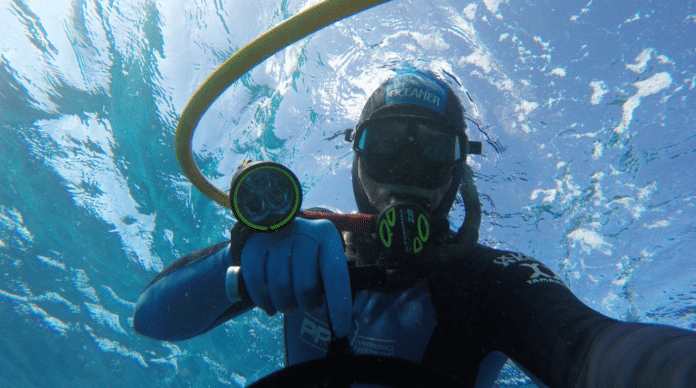WARNING: Some of the practices discussed here are outside of currently-accepted sport diving industry practices and can be dangerous and result in injury or death if conducted incorrectly and or without appropriate knowledge.
This summer, Performance Freediving International (PFI), plans to launch the world’s first “mixed gas” freediving course aimed at professionals such as competition safety divers and instructors, under the moniker “technical freediving.” PFI defines this as freediving augmented by breathing an oxygen-enriched gas mix and or pure oxygen before, during, or after a freedive. For practical purposes they mean a nitrox mix (an oxygen-nitrogen gas mix); helium is not a suitable gas for freediving.
The program is the brainchild of 50-year old PFI founder and CEO, Kirk Krack, a pioneer and innovator in breath-hold education, who coined the term and has deployed mixed gas technology in various forms since 2001 and used it to support his safety divers for PFI’s annual “Deja Blue” competition since 2014. He has also used mix extensively in his underwater film work, most recently as a freediving safety, training and educational consultant for James Cameron’s Avatar II, which will be released in December 2021.
Though the course is aimed at “working” divers, Krack, who is a former trimix instructor trainer and mixed gas diver, believes it will ultimately have a broader appeal. “I see technical freediving creating a following and style of its own, much like technical diving parallels recreational scuba diving today. I hope it will lead to new expeditionary styles of freediving as well as more procedural and equipment innovations,” he explained.
Why would freedivers pre-breathe a gas mix like nitrox, instead of simply filling their lungs with atmospheric air? For the same reason, that compressed gas divers from the sport, commercial and military diving communities use mix technology: to reduce or eliminate the physiological effects induced by pressure, enabling divers to dive deeper, stay longer and with increased relative safety.
Why would freedivers pre-breathe a gas mix like nitrox, instead of simply filling their lungs with atmospheric air? For the same reason, that compressed gas divers from the sport, commercial and military diving communities use mix technology: to reduce or eliminate the physiological effects induced by pressure, enabling divers to dive deeper, stay longer and with increased relative safety.
“Nitrox adds a dramatic safety factor,” offered 44-year-old former world record holder, inventor, and engineer Eric Fattah, who invented the Liquivision F1 freediving computer, fluid goggles and first popularized Frenzel and mouth-fill equalization. Fattah has practiced nitrox freediving since 2009 and is convinced that in addition to increasing dive times, nitrox breath-ups could practically eliminate the risk of hypoxia—the primary risk in freediving. “CO2 becomes the limiting factor when diving with nitrox. It’s almost impossible to blackout,” he said. The claim has not been tested.
Nor has the technology been endorsed by the freediving establishment. “We allow PFI to use nitrox [for safety divers] as a consideration, but it is not encouraged. There are too many possible complications,” explained Carla Hanson, president of the International Association for Development of Apnea (AIDA), which is one of two international organizations that judge freediving competitions. “Of course, breath-ups on oxygen are used as a stunt for the Guinness Records. But it’s just a stunt,” she added. In contrast, technical freedivers consider it a tool.
Will the community join its scuba diving counterparts and embrace mix technology? If history is any judge, the move is all but inevitable; there are substantive physiological benefits to be had and the risks are manageable. In fact, freedivers and spearos are using it now.
The more intriguing question is how fast and to what extent the adoption will take place. The fact that PFI has just joined the SDI|TDI|ERDI family of training agencies, which will expose tech freediving to thousands of techies and tech instructors who think nothing of breathing off a nitrox stage bottle, will no doubt serve to boost awareness and use.
Like tech diving before it, the adoption of mixed gas technology by breath-hold divers truly represents a move to go where “No One Has Gone Before.” However, unlike its scuba counterpart, freediving has some unique data challenges that need to be addressed if technical freediving is to realize its full potential.
A Brief Mix Primer
The fundamental concept behind mixed gas technology is to optimize a diver’s breathing gas for their planned exposure. The goal is to reduce or eliminate any undesirable physiological effects induced by pressure in order to improve diver safety and performance.
The technology was first developed by the U.S. Navy in the 1930s for use with surface-supplied diving systems to overcome the debilitating effects of nitrogen narcosis associated with deep air diving. Their mission was to be able to rescue sailors from downed submarines. Mix was later adopted by commercial oil-field divers in the early 1960s, as offshore oil field diving, moved beyond about 200-250 fsw/61-76 MSW, exceeding the practical limits of compressed air diving.
Finally, during the late 1980s and early 1990s, amateur cave and wreck divers, who were pushing beyond the limits of air, adapted mix technology for use with scuba and later rebreathers to further their explorations. Their efforts gave rise to what is now known as technical diving, and also introduced nitrox for recreational diving. As it turns out, compressed air is rarely the best choice to breathe underwater, as highlighted by the Global Underwater Explorers (GUE) meme, “Compressed air is for tires!”
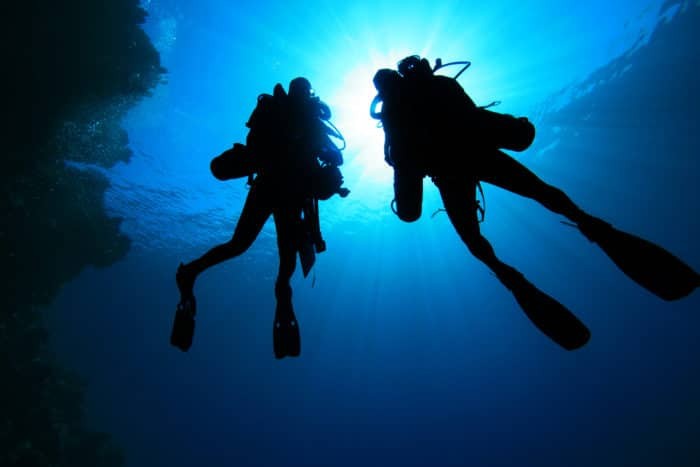
Technical divers optimize their breathing gas according to three critical physiological constraints. First, they seek to elevate and maintain oxygen levels as high as possible subject to central nervous system (CNS) oxygen toxicity limits, in order to minimize inert gas uptake and thereby reduce potential decompression requirements.
Second, they select gases to reduce or eliminate undesirable inert gas effects such as nitrogen narcosis for deep dives and to facilitate off-gassing on an ascent. Finally, they seek to reduce breathing gas density and therefore the work of breathing in order to minimize CO2 build-up, which can cause narcosis, blackouts and potentiate other problems.
In practice, this means that divers breath nitrox for shallow dives in the 0-130 ft/40 m range. For example, a standard nitrox 32 (32% O2, 68% nitrogen) has a higher oxygen fraction and less nitrogen than air (21% O2, 79% nitrogen) giving the diver significantly more “no-stop” time or depending on the dive, less decompression.
For deep dives, technical divers typically breathe “trimix,” a blend of oxygen, helium, and nitrogen, derived by reducing the oxygen fraction (%) for the target depth (to avoid oxygen toxicity), and substituting helium, which is non-narcotic, for some or all of the nitrogen found in air. The addition of helium, which is seven times lighter than nitrogen, also decreases gas density, making it easier to breathe and minimizing CO2 build-up.
Finally, (open circuit) tech divers take advantage of “accelerated decompression” by switching to one or more decompression gases, primarily nitrox with increasingly higher oxygen fractions during ascent and decompression, to facilitate off-gassing. Note that a closed-circuit rebreather mixes the diver’s breathing gas on-the-fly based on their settings and diluent gas choice, resulting in a near-optimal gas mix at every depth.
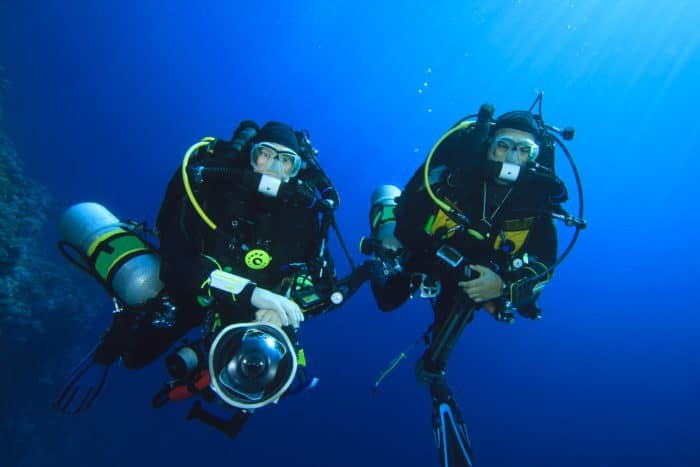
Mixed Gas Freediving Anyone?
Though the physiological constraints that control breath-hold dives are different than those of scuba diving, the concept of mix technology i.e. optimizing a diver’s breathing gas for the dive is still applicable. After all, whether a diver is breathing from a regulator, or holding their breath, they are still consuming compressed gas underwater.
After all, whether a diver is breathing from a regulator, or holding their breath, they are still consuming compressed gas underwater.
In fact, the dramatic potential for mixed gas use with freediving is evident when looking at static breath-holds. The current AIDA world record static breath-hold for men (breathing air) is 11:35 minutes, which was established by Stéphane Mifsud in 2009. By contrast, the current Guinness world record breath-hold set by Aleix Segura in 2016 following an oxygen pre-breathe, is more than double that at 24:03 minutes.
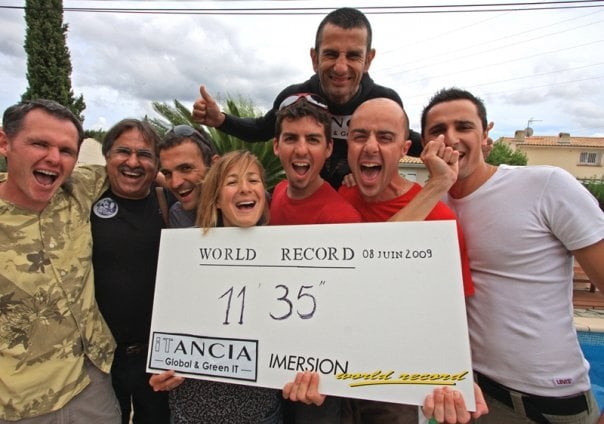
It was precisely this effect, that first caught Krack’s attention back in 1998 when he was training Tanya Streeter for her then world record freedive. After breathing nitrox 80 (80% O2, 20% nitrogen) at the surface as a recovery aid following a series of deep training dives, Krack descended to communicate via slate with a pair of decompressing safety divers. While they were chatting, Krack “accidentally” held his breath for more than 5-minutes, much to the astonishment of the divers who kept pointing to his dive computer. “I was like, ‘Ah, of course, I was breathing 80%, and I filed it away in my brain for a later time,” Krack recalled.
How Does It Work?
Despite continued advances in depth and time in apnea diving, hypoxia, hypercapnia, and inert gas loading remain the key limiting factors for breath-hold dives. Breathing an oxygen-enriched nitrox mix or pure O2 prior to a freedive, increases the PO2 in the diver’s lungs, bloodstream and other tissues such as muscle while decreasing the partial pressure of nitrogen (PN2). Note that because helium is absorbed by tissues faster than nitrogen, it could likely cause increased DCS risk in freedivers who conduct rapid ascents, making it unsuitable as a breath-hold gas.
By pre-breathing nitrox, for example, a nitrox mix somewhere between 32% and 50% oxygen, in conjunction with hyperventilation, which decreases the partial pressure of carbon dioxide (PCO2), the diver has additional oxygen to facilitate respiration during the dive; decreased nitrogen, which reduces inert gas loading, and therefore decreases decompression stress and also potential nitrogen narcosis, and decreased carbon dioxide which drives the urge to breathe. As a result, the diver will be able to dive longer before hypoxia and or hypercapnia mandate ascent.
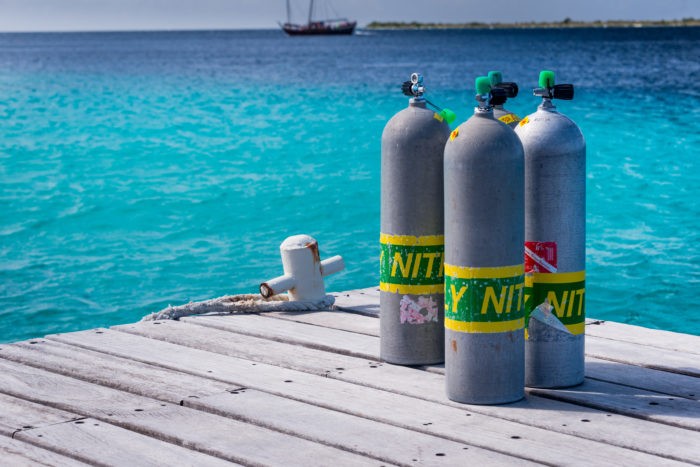
In addition to pre-breathing, freedivers might also take their final breath-hold from a scuba regulator underwater, enabling them to take in more gas than they could at the surface effectively accomplishing “lung packing.” For example, taking a breath at 20 ft/6 m (1.6 ATA) increases the breath-hold volume by a factor of 1.6, potentially giving them more bottom time (Krack argues that taking a single breath underwater is clearly different from sustained underwater breathing). Of course, the diver would need to exhale at an appropriate depth upon ascent to avoid an overexpansion injury. Of course, freedivers generally exhale before surfacing, so to be able to immediately breathe.
Finally, breathing a high-oxygen mix such as nitrox 50, 80 or pure O2 after the dive rapidly corrects the diver’s relative or critical hypoxic state, helps metabolize lactic acid and waste products, and speeds off-gassing of nitrogen. As a result, a tech freediver can recover more quickly from the metabolic demands of the dive and reduce cumulative decompression stress and the likelihood of getting bent. In fact, like their scuba counterparts, tech freedivers including working safety divers report having less fatigue at the end of a dive of diving when diving with nitrox and or O2.
Depending on the dive, the freediver may also choose to do their recovery breathing underwater, increasing the pressure gradient to flush the nitrogen from their system. They may also switch gases, albeit at the surface, for example, switching from a nitrox 80 or pure O2 recovery gas to a leaner nitrox 32 or 40 as a pre-breathe for the next dive, and even adding “air breaks” to flush the lungs before diving, in order to minimize the risk of oxygen toxicity as discussed below.
Tech freedivers also sometimes employ diver propulsion vehicles (DPVs) or scooters for propulsion, which can nearly eliminate physical exertion and consequently CO2 build-up during the dive, enabling the diver to achieve even greater depths and dive time.
Expeditionary Freediving
In January 2017, Krack and a pair of PFI staff instructors conducted the first technical freediving expedition at Truk Lagoon aboard the Truk Master. You might think of it as a mini apneic version of Dr. Bill Stone’s 1987 Wakulla Springs Project that kicked off tech diving.
Armed with DiveX Piranha scooters, varying nitrox mixes, oxygen, primary lights, GoPros, long fins, open-cell neoprene wetsuits, and a carbon-fiber downline system, Krack and his team made over 100 dives a day to depths of 30-65m/100-197 ft with bottom times averaging 3:00-5:00 minutes. This included dives with breath-holds exceeding six minutes on the Nippo Maru laying at 40m/132 ft.
PFI’s technical freediving procedures enabled the team to make an unprecedented number of repetitive dives, reduce their surface intervals by up to 40% using nitrox 80 and O2, and enjoy 10 days of diving with extreme depth and duration without incident or unusual fatigue. “I personally found it very exciting to jump on a scooter and do a really comfortable six-minute plus freedives circumnavigating a wreck in Truk Lagoon at 40m and then repeat that a dozen more times during that ocean session,” Krack said.
Fattah, who trained with Krack and has also been an innovator in freediving equipment and methods, is arguably a poster child for expeditionary freediving. “Nitrox has opened up my ability to explore. I feel like I’m using my O2 efficiently almost like CCR (closed circuit rebreather) for way less cost,” he said.
Though a nitrox cylinder can easily be staged on a freedivers float when line diving, Fattah says its often impractical for exploring Vancouver’s inland waterways, where there are currents and it may be difficult to get back to the float. Instead, Fattah carries a 6 ft3 pony bottle with a built-in Spare Air style regulator strapped to his forearm. He typically fills the cylinder, which holds about 120 breaths at the surface, with nitrox 40, and breaths from it in between dives. “The total time I get to spend underwater is extraordinary because of the longer dive times,” Fattah said.
He has also experimented with taking a breath at depth, be careful to let the excess gas escape leisurely on the ascent. “I don’t share others’ paranoia about embolism. I rarely take a breath underwater when I am diving nitrox but one situation I do is when I hear a boat coming,” explained Fattah who said he has had close calls in the past where visibility has been poor, and he’s tried to stay underwater while avoiding a blackout. “With nitrox, you can stop at eight meters, take an extra breath, which gives you several minutes to wait out the boat. It has allowed me to dive in several new areas,” he said.
WARNING: Taking a breath of compressed gas at depth during a breath-hold dive can result in an over-expansion injury, embolism and possibly death if the diver fails to exhale the excess gas on the ascent.
Fattah has even investigated exhaling at the surface, taking a single kick to negative buoyancy, and then breathing nitrox at 15 m/50 ft, thus eliminating most of his CO2 load, which is typically generated in the first part of the dive, and then continuing his descent. Note that a breath from a regulator at 15 m/50 ft, that is 2.5 ATA gives the diver 2.5 breaths of air. “It gives you a huge advantage, with all that oxygen and little CO2. Someone in top shape could easily do a 10-minute dive” he said.
Clearly, the reclusive Fattah, who has an unorthodox approach to diving is not shy about his views. “I’m an advocate of nitrox. It adds a dramatic safety factor and practically eliminates surprise blackouts. I have had close calls with air but none on nitrox, not even close,” he said.
With the risk of blackouts diminished, the limiting factor on nitrox dives becomes CO2, i.e. the overpowering urge to breathe. According to Fattah, by pushing dive times, it is possible to experience CO2 narcosis, another potential risk factor. “The narcosis grows exponentially once you start to feel it and you get woozy. At that point I stop and go up,” he explained, noting that there’s a potential risk of a CO2 blackout, but it would likely follow contractions, and would consequently not be a surprise.
OXTOX Redux
A primary risk in (open circuit) mixed gas diving is CNS oxygen toxicity, resulting from short exposures to high PO2s[1] at greater than atmospheric pressure (i.e. PO2 > 1.0 atm), and can cause nausea, dizziness, convulsions, and unconsciousness. Though the convulsions themselves are harmless, the immediate risk to divers is losing their mouthpiece and drowning.
Oxygen toxicity sometimes referred to as the “Paul Bert effect,” was one of the leading causes of death in early tech diving resulting from divers breathing a mix with too high of a PO2 at depth. This was usually the result of divers not analyzing, and or not labeling or mislabeling, their gas mixes before use, and also the lack of reliable gas switching protocols. CNS toxicity was also a concern in early recreational nitrox diving, though it has proved to be a non-issue in practice.
Oxygen toxicity is a time-dose phenomenon, that is, it depends on both the level of PO2 and the cumulative exposure time. The dose starts accumulating when PO2s reach 1.0 or above. The thinking today is that compressed gas divers should not exceed a maximum PO2 of 1.6 atm (down from 2.0 atm in the 1950s), which is generally considered the threshold for convulsions, though rare incidents have occurred at 1.4 atm. In fact, the trend in oxygen management over the last 30 years is towards greater conservatism.
The most widely used oxygen exposure limits today are those developed by the National Oceanic and Atmospheric Administration (NOAA) and published in the 1991 version of the NOAA Diving Manual, shown in Figures 1 & 2. For each level of oxygen, the chart shows an allowable time for a single exposure and also an accumulated time at that level over a full day. In practice, a diver’s total exposure is calculated by accumulating the time/PO2 exposures for each segment of the dive and tracked by most dive computers, in what is known as the “CNS Clock.”

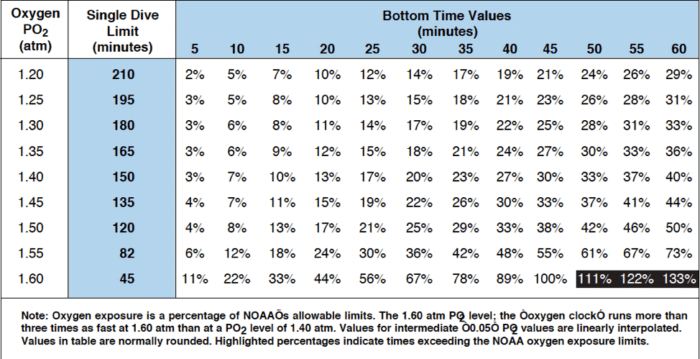
For comparison, Figure 3 shows the US Navy’s earlier oxygen exposure limits for nitrox diving from 1956.
Figure 3: USN Oxygen Exposure Limits for Nitrogen-Oxygen Mixed-Gas Diving (1956)
| Normal Exposures | |
| Oxygen Partial Pressure (ata) 1.6 1.5 1.4 1.3 1.2 1.1 1.0 |
Time (min) 30 40 50 60 80 120 240 |
| Exceptional Exposures | |
| Oxygen Partial Pressure (ata) 2.0 1.9 1.8 1.7 1.6 1.5 1.4 1.3 |
Time (min) 30 40 50 60 80 120 240 |
Note that there is a wide variation in susceptibility to O2 toxicity among individuals, and a significant variation in a single individual at different times due to environmental and physiological factors. Susceptibility to CNS toxicity is also increased by increases in PCO2, for example as a result of exercise, increased work of breathing, or in the case of freediving, apneic carbon dioxide build-up. That is the reason that technical divers are recommended to take a conservative approach. Conversely, toxicity can be reduced or postponed by taking “breaks” from breathing high PO2s, for example taking “air breaks” during oxygen decompression, to lower the risk of convulsions.
Tech divers manage their risk by staying within the CNS exposure limits. In practice, they generally select a bottom gas mix that results in PO2s up to 1.2-1.4 atm during the working portion of their dive and boosts their PO2s to the maximum of 1.6 atm while breathing decompression gas. For very deep and or very long dives tech divers often lower their oxygen levels further to reduce the risk of convulsion.
Breath-Hold Toxicity?
PFI manages the risk of oxygen toxicity for tech freediving based on the oxygen exposure limits for compressed gas diving. For instance, under PFI protocols, the diver would choose a pre-breathe mix based on the target depth of the dive in order to maintain the freediver’s PO2 at 1.6 atm or less at their maximum depth.
That means for a dive on the Nippo Maru at 40m, a tech freediver would pre-breathe a nitrox 32 resulting in a max PO2 of 0.32 x 5 atm (40m/10m +1) =1.6 atm. Conversely, if the diver pre-breathed a nitrox 50 mix, PFI protocols would mandate that the dive be limited to 22m/72 ft. By way of comparison, an “air-based” freedive to 80m represents an exposure of 0.21 x 9 atm (80m/10m +1) =1.8 atm, and a 100m air-based freedive exposes the diver to a maximum PO2 of 2.3 atm.
PFI also provides for team-based surface-based gas switches. For example, if a freediver was breathing a nitrox 80 or O2 post-dive for recovery, they would switch to an appropriate gas with a lower oxygen fraction targeted to their target depth before their next dive. They also have protocols for taking a two-minute[2] “air break” before a dive after breathing a nitrox mix, where the PO2 would exceed 1.6 atm at the target depth, to flush out the excess oxygen from the lungs and buffer against CNS toxicity. Given the nature and length of the exposure in a typical freedive, PFI protocols, which are based on compressed gas diving limits, represent a highly conservative approach to oxygen management.
Given the nature and length of the exposure in a typical freedive, PFI protocols, which are based on compressed gas diving limits, represent a highly conservative approach to oxygen management.
By comparison, Fattah is a little more aggressive in managing his oxygen management. “I have no hesitancy to dive to 40-45 m with a nitrox 40 [max PO2=2.0-2.5]. If the dive were over 50m, I would limit it to one or two dives,” Fattah explained. His reasoning is as follows; First, the freediver is consuming the oxygen in his or her lungs and tissues as they descend, resulting in a lower PO2 than a diver breathing the same gas at depth.
Second, the exposure time per dive is significantly less than a compressed gas dive. Even on Krack’s 6-minute Nippo Maru dive, the time at maximum PO2 was less than 4-5 minutes. This compares to a single maximum exposure of 45 minutes according to NOAA’s CNS clock. But how about if you repeat the dive 12 times in an afternoon? The issue is the cumulative exposure from repetitive free dives. In addition, the diver is essentially getting “breaks” (PO2s < 1.0 atm) in between dives, even if they were post-breathing nitrox 50 or 80 (at the surface), which would offer some recovery.
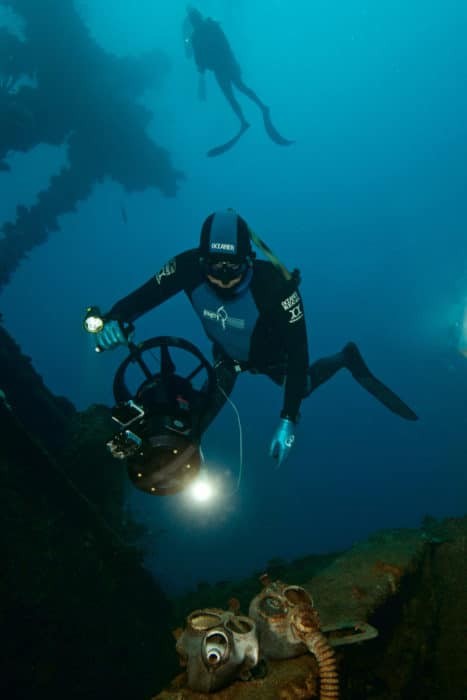
I asked Dr. John Clarke, who was then scientific director of the US Navy Experimental Diving Unit (NEDU), if a freediver pre-breathed pure oxygen, then did a breath-hold dive to 30m (Max PO2=4.0), would they tox? He said, that he didn’t know but thought it was probably unlikely, for the arguments above. Again, the issue for freediving is managing oxygen exposures on repetitive dives.
The point is, that unlike early tech diving, which built upon the U.S. Navy and NOAA’s research on compressed gas diving, much of it done in the 1930-1960s, no one has developed oxygen exposure tables or an equivalent CNS clock for freediving. No one knows what the limits are!
Unfortunately, the needed research will likely be difficult to come by for at least two reasons. First, freediving is a niche within a niche and is not a critical research item for traditional sources of hyperbaric research such as the U.S. Navy and NOAA.
Second, it might be difficult to get approval from university ethics boards, even if freedivers volunteered to participate. “Freediving oxygen toxicity studies are not something that most university ethics boards would be comfortable with,” explained Neal Pollock, research chair for hyperbaric medicine at the Centre de médecine de plongée du Québec, at the recent OZTek Advanced Diving Conference. The lack of relevant data on oxygen exposure limits is clearly one of the challenges facing technical freediving.
As an intriguing aside, pioneering decompression consultant Jean-Pierre Imbert, recently suggested to me in a Skype call that a small amount of the inert gas argon or xenon, which have been shown to suppress CNS toxicity, might be added to a tech freediver’s pre-breathe mix, creating a kind of ‘exotic’ trimix (oxygen, nitrogen, argon/xenon) to enable them to pre-breathe a high-oxygen mix without fear of convulsions at depth. Again, additional research is needed on this subject.
Deco for (Free)Divers
Though the incident rate is very low, freedivers can get decompression sickness (DCS) when conducting single deep dives, especially beyond about 100 m, and deep repetitive dives. Pre-breathing an oxygen-enriched nitrox mix, which reduces a diver’s inert gas loading, generally reduces decompression stress (bubbling) and the risk of DCS. It may also reduce flying after freediving protocols.
PFI’s safety divers, who may easily make 40-60 or more dives a dive during a competition, use nitrox as a buffer the same way that scuba divers add conservatism by breathing nitrox but following air decompression tables. That is, as a result of pre and or post breathing a nitrox mix, safety divers are carrying increased oxygen levels and reduced nitrogen levels, giving them additional oxygen reserves to affect a rescue, and at the same time lowering their risk of DCS, in comparison to diving with atmospheric air.
PFI has also developed protocols for shortening freedivers surface intervals between dives based on breathing a recovery gas such as nitrox 50, 80 or pure O2 after the previous dive. These are basely roughly on the experience of compressed gas divers being able to reduce decompression times breathing air by half or more by using a decompression gas such as nitrox 80 or oxygen. The protocols are anecdotal and not based on hard data.
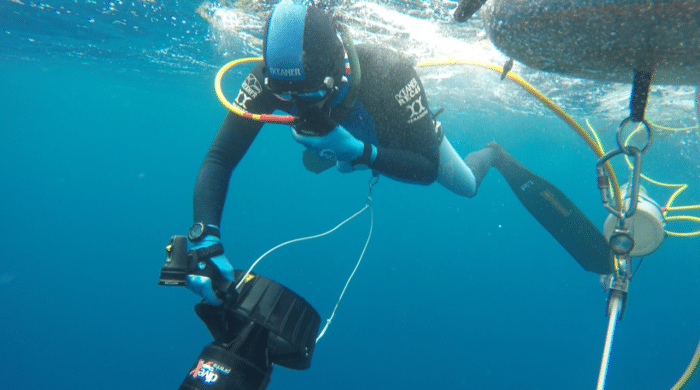
Of course, the ability to reduce surface intervals, decompression stress and or the risk of DCS depends on the dives that are being conducted. Fattah takes exception to the notion that technical freediving reduces decompression risk. “It’s an illusion,” emphasized Fattah who reported that he bent himself multiple times in the process of experimentation. “The risk of DCS increases with the ability to spend more time underwater. Increasing dive times and shorten surface intervals increases your risk.” Note that PFI acknowledges this risk.
Early technical (scuba) divers were able to benefit from the work of decompression researchers like Dr. RW Bill Hamilton, who developed some of the first trimix tables for the tech diving community. Though there was little data on specific technical dive profiles, the underlying algorithms had been validated. Not so the freediving community.
In addition to scant data on freediving profiles and decompression, the algorithms in today’s freediving computers, such as Buhlmann ZHL-16, are based on the dynamics of compressed gas diving, not breath-hold diving, which typically has ascent rates 4-8 times faster than scuba ascents. “Freediving is quite different from compressed gas diving, particularly with its rapid ascent rates. As a result, the algorithms aren’t fully appropriate,” explained Pollock, who is one of the few researchers that has conducted Doppler testing on freedivers.
Interestingly, after founding Liquivision and experimenting with gradient factors, Fattah developed his own freediving decompression algorithm that was based on pressure changes and ascent rates, which he installed one of Liquivision’s Xen computers. His company was bought by Huish in 2014 and closed down.
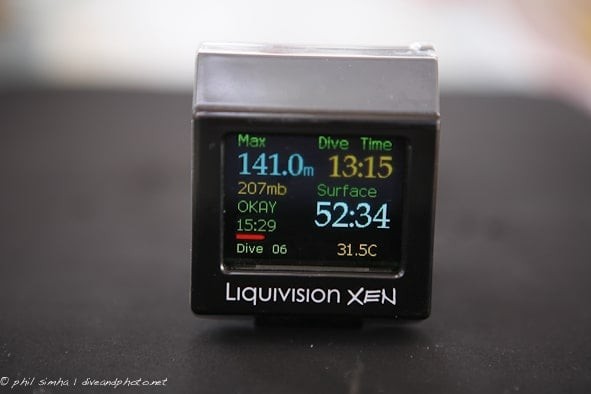
He also experimented with “apnea decompression,” i.e. making a decompression stop at the end of deep freedive, which he acknowledged can be dangerous. “You don’t want to spend time in the blackout zone,” he said. As a result, on big dives, he practiced surfacing and then returning to depth to decompress after a brief recovery. He also experimented with making nitrox stops. “Apnea deco is not great on-air, but a nitrox stop can make sense,” Fattah said.
Calculating decompressions represents another challenge for the tech freediving community, which will need to develop and or have access to evidence-based, breath-hold decompression algorithms in order to fully realize the benefits of tech freediving.
Shearwater? Suunto? Mares? Oceanic? Garmin? Are you listening?
“I am looking forward to having a freediving computer with an algorithm designed for freediving, that also takes into account the different gases I may be using, that and my first sidemount rebreather to save on O2 in remote locations,” mused Krack, who has also suffered neurological DCS while freediving.
Hold Your Breath for Nitrox?
How fast will freedivers adopt nitrox and or O2 as breathing gasses and who are likely to be the early adopters and beneficiaries?
Arguably, “working divers” will be some of the first users for the simple reason that it can improve their workplace safety and performance. In fact, some already are. “It’s an added safety factor for us and for the athletes,” said Lifeguard Sargent for the City of San Diego, California, Ed Harris, who has served as a safety diver for numerous PFI Deja Blue competitions. “Nitrox gives you an extra edge to wait out an athlete who is running behind schedule and help ensure you have the stamina and breath-hold to swim an unconscious diver to the surface.” One of the two fatalities in competitive freediving over the last 30 years, was a diving safety officer who drowned from shallow water blackout while rescuing an athlete from depth in 2017. The athlete survived. If the safety diver had a larger oxygen reserve, it might have made a difference.
The interesting question will be, at what point will the owners of competitions who employ safety divers be judged as NOT offering a “safe workplace” if they do not provide enhanced gases for safety divers recovery and performance? “I think in five years’ time, there will be the obvious areas where it will be fully integrated and understood, for example, for competitive safety divers as well as a recovery gas for competitive freedive training and competition,” Krack said, noting that it is sometimes being used with limited knowledge and appreciation for the risks involved.

Another obvious application is underwater movie making. According to Krack, until recently, there were still anti-nitrox/O2 sentiments by some people in the movie business because of the fear of the unknown and lack of understanding of the advantages of a mix. “With Avatar, the myths should be fully dispelled and its use accepted,” he said. Reportedly, Avatar will feature the most freediving footage ever attempted in a film, most of it done with nitrox.
“I can definitely see it used by freedivers who are getting older, are busy with their family and job and just don’t have the time to fully train and maintain their form that they once had. Technical Freediving will allow them to help even the playing field”
There is also an obvious advantage for spearos to avoid DCS, protect against black-outs, and aid recovery between dives. Though as some have noted, with existing pressures on fish stocks; it would be a shame if nitrox was used to take more fish. Like nitrox scuba diving, it may also likely appeal to older divers. “I can definitely see it used by freedivers who are getting older, are busy with their family and job and just don’t have the time to fully train and maintain their form that they once had. Technical Freediving will allow them to help even the playing field,” Krack explained adding that he respects ‘purists.’
What about freediving enthusiasts? Are they likely to respond like their early tech diving counterparts?
Interestingly, the situation is NOT fully analogous to the early days of technical diving, when mixed gas became the standard within a decade of its introduction. At the time, divers’ depths and bottom times were significantly limited by the use of compressed air, and the deep air dives that were being conducted were extremely dangerous. Most divers were motivated to make the switch particularly after experiencing the lack of narcosis on deep dives. That is not the case in freediving.
“I really don’t see mixed gas as having any real place in the sport. There is still so much room in freediving’s present form to be pushed forward.”
“I really don’t see mixed gas as having any real place in the sport. There is still so much room in freediving’s present form to be pushed forward.” Australian freediving wunderkind and educator Adam Stern, founder of Deep Week, told me with no uncertainty. “It also seems at odds with the ethos of freediving, which is testing the limits of the body on one breath. Mixed gas seems as out of place as does mechanized propulsion.”
What no scooters??
“Jacque Mayol made the first 100-meter dive with No Limits. Today athletes are diving to 100 m with no fins. They don’t need nitrox to help!”
Stern’s point was seconded by PADI Americas Instructor Development Programs Specialist Eric Albinsson, who helps manage PADI’s freediving program. “I agree with Adam. Jacque Mayol made the first 100-meter dive with No Limits. Today athletes are diving to 100 m with no fins. They don’t need nitrox to help!” Of course, part of the appeal is the freeness, not having to worry about the correct mix and tables,” he said. Nitrox has long been PADI’s best-selling specialty scuba course. I asked Albinsson if PADI had a nitrox freediving course in the works. “Not at this point,” he answered. “However, PADI will keep an eye on developments.” They always do!
“I think tech freediving will probably develop for competition safeties but in my personal opinion, I don’t think it will develop as an activity in itself, that is – tech freediving for tech freediving’s sake.”
Nor is RAID planning to offer a technical freediving program anytime soon. “It would irresponsible of us to offer a tech freediving program until more is known about the effects on the diver,” explained Thibault Guignés, RAID Instructor Trainer and French record holder in Free Immersion. “I think tech freediving will probably develop for competition safeties but in my personal opinion, I don’t think it will develop as an activity in itself, that is – tech freediving for tech freediving’s sake. Freediving is all about exploring your own limits, and being free from too much equipment and set up. For longer and deeper dives scuba or tech scuba is more fitting,” Guignés said.
Whatever your perspective, one thing’s certain. Like early tech diving before it, technical freediving is truly taking us where no divers have gone before, and in the process, extending our underwater envelope and our knowledge. While freediving in its all various manifestations, arguably represents the cutting edge of diving; technical freediving is the tip of the spear – a description offered by Drew Richardson, CEO of PADI.
“I think tech freediving it’s going to open up a whole new world of possibilities”
Small wonder, tech freediving generating excitement among the vanguard. “Nearly thirty years ago, I reached as far as I could go as a recreational scuba instructor,” Krack recalled. Wanting to do more he took his first nitrox course in 1992, and within a half a dozen years went on to become a TDI trimix instructor trainer. “It was an adventure that gave me something new to learn, explore, and make my own. Now after 20-plus years being professionally involved in freediving, it’s exciting to dive into something completely new and innovative again. I think tech freediving it’s going to open up a whole new world of possibilities” he said.
Notes
[1] The partial pressure of oxygen or PO2 can be calculated as the fraction or percentage of oxygen (FO2) in a gas mix times the absolute pressure at target depth i.e. 1+ Depth/10 in the case of metric, 1+Depth/33 in imperial. Note that according to Dalton’s Law the partial pressure of a gas mix is the sum of partial pressures of its components.
[2] Krack and his team found that oxygen-levels of a diver’s exhalation fell to ambient levels after two minutes of breathing air following breathing oxygen-enriched nitrox. However, some of the diver’s tissues would still carry reserve oxygen.

